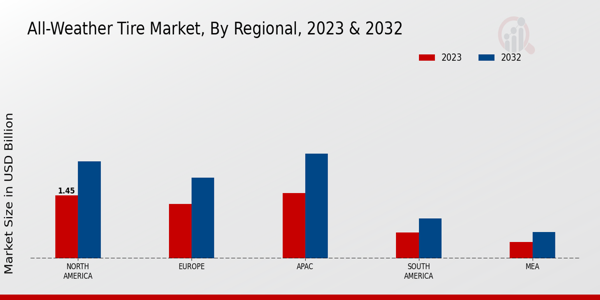Market Growth Projections
The Global All-Weather Tire Market Industry is projected to experience substantial growth over the next decade. With a current valuation of 4.75 USD Billion in 2024, the market is expected to reach approximately 8.34 USD Billion by 2035, reflecting a compound annual growth rate (CAGR) of 5.26% from 2025 to 2035. This growth trajectory indicates a robust demand for all-weather tires, driven by various factors such as technological advancements, increasing vehicle ownership, and heightened consumer awareness regarding tire safety and performance. The market's expansion presents significant opportunities for manufacturers and stakeholders.
Growing Demand for Versatile Tires
The Global All-Weather Tire Market Industry experiences a surge in demand due to the increasing preference for versatile tire solutions. Consumers seek tires that can perform well in various weather conditions, reducing the need for seasonal tire changes. This trend is particularly pronounced in regions with fluctuating climates, where all-weather tires provide a practical solution. As of 2024, the market is valued at approximately 4.75 USD Billion, indicating a robust consumer shift towards these multifunctional products. The convenience and cost-effectiveness of all-weather tires are likely to drive further growth in the industry.
Increasing Vehicle Ownership Rates
The Global All-Weather Tire Market Industry is positively impacted by rising vehicle ownership rates worldwide. As more individuals acquire vehicles, the demand for tires, including all-weather options, escalates. This trend is particularly evident in emerging economies, where urbanization and economic growth contribute to higher disposable incomes and increased vehicle purchases. The projected growth in the market, with an estimated value of 8.34 USD Billion by 2035, underscores the correlation between vehicle ownership and tire demand. Consequently, manufacturers are likely to focus on expanding their all-weather tire offerings to capture this growing consumer base.
Regulatory Support for Tire Safety Standards
Regulatory frameworks promoting tire safety and performance standards significantly influence the Global All-Weather Tire Market Industry. Governments worldwide are increasingly implementing stringent regulations to ensure that tires meet safety and environmental standards. These regulations encourage manufacturers to invest in high-quality all-weather tires that comply with safety requirements. As a result, consumers are more inclined to choose all-weather tires that offer reliable performance across various conditions. This regulatory support not only enhances consumer confidence but also drives market growth as manufacturers adapt to meet evolving standards.
Technological Advancements in Tire Manufacturing
Innovations in tire technology significantly influence the Global All-Weather Tire Market Industry. Manufacturers are increasingly adopting advanced materials and production techniques to enhance tire performance, durability, and safety. For instance, the integration of silica compounds and advanced tread designs improves traction and handling in diverse weather conditions. These technological advancements not only cater to consumer demands for high-performance tires but also align with sustainability goals by reducing rolling resistance and improving fuel efficiency. As the industry evolves, these innovations are expected to play a crucial role in shaping market dynamics.
Environmental Concerns and Sustainability Initiatives
The Global All-Weather Tire Market Industry is increasingly shaped by environmental concerns and sustainability initiatives. Consumers are becoming more aware of the ecological impact of their choices, leading to a preference for tires that are produced with sustainable practices. Manufacturers are responding by developing all-weather tires that utilize eco-friendly materials and production methods. This shift aligns with global efforts to reduce carbon footprints and promote sustainable transportation. As the market evolves, the emphasis on sustainability is expected to drive innovation and growth, appealing to environmentally conscious consumers.























Leave a Comment